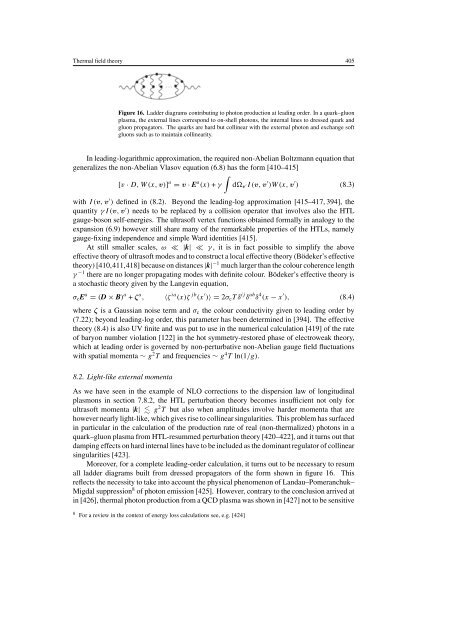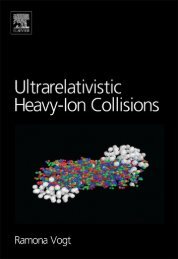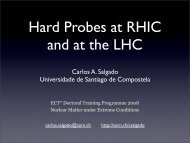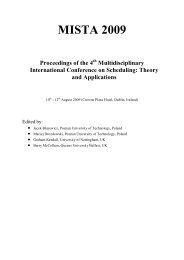Advances in perturbative thermal field theory - Ultra-relativistic ...
Advances in perturbative thermal field theory - Ultra-relativistic ...
Advances in perturbative thermal field theory - Ultra-relativistic ...
You also want an ePaper? Increase the reach of your titles
YUMPU automatically turns print PDFs into web optimized ePapers that Google loves.
Thermal <strong>field</strong> <strong>theory</strong> 405<br />
Figure 16. Ladder diagrams contribut<strong>in</strong>g to photon production at lead<strong>in</strong>g order. In a quark–gluon<br />
plasma, the external l<strong>in</strong>es correspond to on-shell photons, the <strong>in</strong>ternal l<strong>in</strong>es to dressed quark and<br />
gluon propagators. The quarks are hard but coll<strong>in</strong>ear with the external photon and exchange soft<br />
gluons such as to ma<strong>in</strong>ta<strong>in</strong> coll<strong>in</strong>earity.<br />
In lead<strong>in</strong>g-logarithmic approximation, the required non-Abelian Boltzmann equation that<br />
generalizes the non-Abelian Vlasov equation (6.8) has the form [410–415]<br />
∫<br />
[v · D, W(x, v)] a = v · E a (x) + γ d v ′I(v, v ′ )W(x, v ′ ) (8.3)<br />
with I(v, v ′ ) def<strong>in</strong>ed <strong>in</strong> (8.2). Beyond the lead<strong>in</strong>g-log approximation [415–417, 394], the<br />
quantity γI(v, v ′ ) needs to be replaced by a collision operator that <strong>in</strong>volves also the HTL<br />
gauge-boson self-energies. The ultrasoft vertex functions obta<strong>in</strong>ed formally <strong>in</strong> analogy to the<br />
expansion (6.9) however still share many of the remarkable properties of the HTLs, namely<br />
gauge-fix<strong>in</strong>g <strong>in</strong>dependence and simple Ward identities [415].<br />
At still smaller scales, ω ≪ |k| ≪ γ , it is <strong>in</strong> fact possible to simplify the above<br />
effective <strong>theory</strong> of ultrasoft modes and to construct a local effective <strong>theory</strong> (Bödeker’s effective<br />
<strong>theory</strong>) [410,411,418] because on distances |k| −1 much larger than the colour coherence length<br />
γ −1 there are no longer propagat<strong>in</strong>g modes with def<strong>in</strong>ite colour. Bödeker’s effective <strong>theory</strong> is<br />
a stochastic <strong>theory</strong> given by the Langev<strong>in</strong> equation,<br />
σ c E a = (D × B) a + ζ a , 〈ζ ia (x)ζ jb (x ′ )〉=2σ c Tδ ij δ ab δ 4 (x − x ′ ), (8.4)<br />
where ζ is a Gaussian noise term and σ c the colour conductivity given to lead<strong>in</strong>g order by<br />
(7.22); beyond lead<strong>in</strong>g-log order, this parameter has been determ<strong>in</strong>ed <strong>in</strong> [394]. The effective<br />
<strong>theory</strong> (8.4) is also UV f<strong>in</strong>ite and was put to use <strong>in</strong> the numerical calculation [419] of the rate<br />
of baryon number violation [122] <strong>in</strong> the hot symmetry-restored phase of electroweak <strong>theory</strong>,<br />
which at lead<strong>in</strong>g order is governed by non-<strong>perturbative</strong> non-Abelian gauge <strong>field</strong> fluctuations<br />
with spatial momenta ∼ g 2 T and frequencies ∼ g 4 T ln(1/g).<br />
8.2. Light-like external momenta<br />
As we have seen <strong>in</strong> the example of NLO corrections to the dispersion law of longitud<strong>in</strong>al<br />
plasmons <strong>in</strong> section 7.8.2, the HTL perturbation <strong>theory</strong> becomes <strong>in</strong>sufficient not only for<br />
ultrasoft momenta |k| g 2 T but also when amplitudes <strong>in</strong>volve harder momenta that are<br />
however nearly light-like, which gives rise to coll<strong>in</strong>ear s<strong>in</strong>gularities. This problem has surfaced<br />
<strong>in</strong> particular <strong>in</strong> the calculation of the production rate of real (non-<strong>thermal</strong>ized) photons <strong>in</strong> a<br />
quark–gluon plasma from HTL-resummed perturbation <strong>theory</strong> [420–422], and it turns out that<br />
damp<strong>in</strong>g effects on hard <strong>in</strong>ternal l<strong>in</strong>es have to be <strong>in</strong>cluded as the dom<strong>in</strong>ant regulator of coll<strong>in</strong>ear<br />
s<strong>in</strong>gularities [423].<br />
Moreover, for a complete lead<strong>in</strong>g-order calculation, it turns out to be necessary to resum<br />
all ladder diagrams built from dressed propagators of the form shown <strong>in</strong> figure 16. This<br />
reflects the necessity to take <strong>in</strong>to account the physical phenomenon of Landau–Pomeranchuk–<br />
Migdal suppression 8 of photon emission [425]. However, contrary to the conclusion arrived at<br />
<strong>in</strong> [426], <strong>thermal</strong> photon production from a QCD plasma was shown <strong>in</strong> [427] not to be sensitive<br />
8 For a review <strong>in</strong> the context of energy loss calculations see, e.g. [424]







